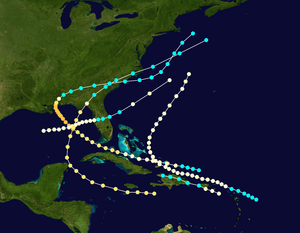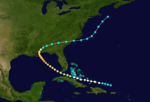1852 Atlantic hurricane season
The 1852 Atlantic hurricane season was one of only three Atlantic hurricane seasons in which every known tropical cyclone attained hurricane status.[1] Five tropical cyclones were reported during the season, which lasted from late August through the middle of October; these dates fall within the range of most Atlantic tropical cyclone activity, and none of the cyclones coexisted with another. Though there were officially five tropical cyclones in the season, hurricane scholar Michael Chenoweth assessed two of the cyclones as being the same storm.[2] There may have been other unconfirmed tropical cyclones during the season, as meteorologist Christopher Landsea estimated that up to six storms were missed each year from the official database; this estimate was due to small tropical cyclone size, sparse ship reports, and relatively unpopulated coastlines.[3]
| 1852 Atlantic hurricane season | |
|---|---|
 Season summary map | |
| Seasonal boundaries | |
| First system formed | August 19, 1852 |
| Last system dissipated | October 11, 1852 |
| Strongest storm | |
| Name | One |
| • Maximum winds | 120 mph (195 km/h) (1-minute sustained) |
| • Lowest pressure | 961 mbar (hPa; 28.38 inHg) |
| Seasonal statistics | |
| Total storms | 5 |
| Hurricanes | 5 |
| Major hurricanes (Cat. 3+) | 1 |
| Total fatalities | 100+ direct |
| Total damage | $1 million (1852 USD) |
Season summary
Every tropical cyclone in the season was of hurricane status, or with winds at or exceeding 74 mph (119 km/h). In only two other seasons did every cyclone attain hurricane status; those years were 1858 and 1884.[1] All five cyclones affected land; the strongest was the first storm, which caused severe damage and loss of life when it made landfall near the border between Mississippi and Alabama. The second storm of the season struck Puerto Rico, where it caused over 100 deaths, primarily from flooding. In the middle of September, the third storm moved across Florida with strong wind gusts and light rainfall, and a week later the fourth storm passed over or north of the Lesser and Greater Antilles. The last storm hit the Florida Panhandle, though damage was less than expected.
Timeline

Systems
Hurricane One
| Category 3 hurricane (SSHWS) | |
 | |
| Duration | August 19 – August 30 |
|---|---|
| Peak intensity | 115 mph (185 km/h) (1-min) 961 mbar (hPa) |
The Great Mobile Hurricane of 1852 was the first tropical cyclone of the year. It was first observed on August 19 about 140 mi (230 km) north of Puerto Rico. It moved on a west-northwest motion before passing through the Bahamas as it attained hurricane status on August 20. After paralleling the northern coast of Cuba, the storm passed between the Dry Tortugas and Key West, Florida on August 22, and two days later it is estimated the hurricane attained peak winds of 115 mph (185 km/h). The storm slowed on August 25 before turning northward, and early on August 26 it made landfall near Pascagoula, Mississippi at peak strength, and the hurricane rapidly weakened to tropical storm status as it accelerated east-northeastward. On August 28 it emerged into the Atlantic Ocean from South Carolina, and after turning to the northeast, it was last observed on August 30 about 130 mi (200 km) southeast of Cape Cod.[4]
In the Florida Keys, rough waves forced several ships ashore, leaving some damaged.[5] Strong waves created four new channels in the Chandeleur Islands, and the storm's passage also destroyed the island lighthouse; the three keepers were found three days later. Two schooners were also washed ashore along Cat Island.[6] The hurricane produced an estimated storm tide of 12 feet (3.7 m) in Mobile, Alabama,[4] where strong winds damaged much of the city, leaving the majority of the houses destroyed. Trees were downed up to 30 miles (50 km) inland,[7] and coastal areas were flooded. Damage along the coastline was estimated at around $1 million (1852 USD, $26 million 2008 USD), and several lives were lost.[8] While crossing the southeastern United States, the storm brought light rainfall but moderately strong winds; in Charleston, South Carolina, the storm destroyed several bridges and crop fields.[4][9]
Hurricane Two
| Category 1 hurricane (SSHWS) | |
 | |
| Duration | September 5 – September 6 |
|---|---|
| Peak intensity | 80 mph (130 km/h) (1-min) |
Hurricane San Lorenzo of 1852
Early on September 5, a hurricane was first observed about 65 mi (110 km) southeast of Christiansted in the Danish Virgin Islands.[1] One meteorologist assessed the hurricane as being located near Antigua on September 3.[2] Tracking steadily west-northwestward, it quickly moved ashore near Ponce, Puerto Rico with winds estimated at 80 mph (130 km/h). After crossing southwestern Puerto Rico, the hurricane emerged into the Mona Passage as a tropical storm. Late on September 5 it made landfall on eastern Dominican Republic; it quickly weakened over Hispaniola, dissipating on September 6 over the northwestern portion of the island.[1] An assessment by scholar Michael Chenoweth in 2006 indicated this storm was the same as the next hurricane, with it continuing northwestward and ultimately reaching the Gulf of Mexico.[2] Due to not being considered the same cyclone in the official hurricane database,[1] this hurricane and the following hurricane are listed separately.
[4] There, the passage of the storm caused severe flooding, which destroyed large quantities of crops and damaged several roads. Storm damage was heaviest between Guayanilla and Mayagüez.[10] More than 100 people were killed in Puerto Rico,[11] many of which due to flooding.[10]
Hurricane Three
| Category 1 hurricane (SSHWS) | |
 | |
| Duration | September 9 – September 13 |
|---|---|
| Peak intensity | 80 mph (130 km/h) (1-min) 985 mbar (hPa) |
A hurricane was located in the central Gulf of Mexico on September 9,[1] potentially the same hurricane as the previous storm.[2] It tracked generally eastward toward the coast of Florida, with its hurricane intensity estimation based on two ship reports. At about 0000 UTC on September 12, it moved ashore near Clearwater, Florida as a minimal hurricane, with an estimated minimum barometric central pressure of 985 mbar. Accelerating east-northeastward while crossing the state, the cyclone emerged into the Atlantic Ocean as a weakened tropical storm before regaining hurricane status on September 13. Later that day, it was last observed about 250 mi (400 km) east-southeast of Cape Hatteras.[1]
A post in Fort Meade, Florida reported at least 0.55 in (14 mm) of rainfall during the storm's passage. The hurricane was considered "violent", and gusts were estimated to have reached hurricane force.[4] Rough seas and strong easterly winds beached a vessel near St. Augustine.[12][13]
Hurricane Four
| Category 1 hurricane (SSHWS) | |
 | |
| Duration | September 22 – September 30 |
|---|---|
| Peak intensity | 90 mph (150 km/h) (1-min) |
On September 22, a tropical storm was located about 200 mi (330 km) east of Guadeloupe. With a steady west-northwest path, the storm moved across the northern Lesser Antilles on September 23, during which it intensified into a hurricane. It passed a short distance north of Puerto Rico and the Dominican Republic as it reached its peak intensity of 90 mph (150 km). Late on September 26 the hurricane turned northwestward, bringing it through the Turks and Caicos Islands and eastern Bahamas. Recurving north-northeastward, the cyclone moved into open waters, and was last classified as a tropical cyclone on September 30 about 390 mi (630 km) east of Cape Hatteras.[1] However, one hurricane researcher assessed the hurricane as lasting until October 3, with the cyclone turning eastward and dissipating near the Azores.[2]
Hurricane Five
| Category 2 hurricane (SSHWS) | |
 | |
| Duration | October 6 – October 11 |
|---|---|
| Peak intensity | 105 mph (165 km/h) (1-min) 969 mbar (hPa) |
A moderately strong hurricane with winds of 105 mph (165 km/h) was first spotted on October 6 east of Jamaica. Passing a short distance south of the island, the hurricane tracked northwestward and brushed the Yucatán Peninsula before turning north-northeastward into the Gulf of Mexico.[1] Late on October 9, it made landfall a short distance east of Apalachicola, Florida at peak winds with an estimated pressure of 969 mbar.[14] Rapidly weakening to tropical storm status, the cyclone continued northeastward and emerged into the Atlantic Ocean from North Carolina on October 11. Later that day, it was last observed about 250 mi (400 km) southeast of Cape Cod.[1]
Heavy damage was reported in Jamaica. Upon making landfall in Florida, the hurricane produced a 7 ft (2 m) storm tide, and in Georgia, hurricane-force winds extended into the southwestern portion of the state,[1] while tropical storm force winds occurred along the coastline. In the state, moderate winds damaged trees and roofs, though the destruction was less than anticipated.[12]
See also
- Atlantic hurricane season
- List of Atlantic hurricanes
References
- "Atlantic hurricane best track (HURDAT version 2)" (Database). United States National Hurricane Center. May 25, 2020.
- Michael Chenoweth (2006). "A Reassessment of Historical Atlantic Basin Tropical Cyclone Activity, 1700–1855" (PDF). Hurricane Research Division. Archived (PDF) from the original on 28 May 2008. Retrieved 2008-05-25.
- Chris Landsea (2007). "Counting Atlantic Tropical Cyclones Back to 1900" (PDF). American Meteorological Society. Archived (PDF) from the original on 14 July 2007. Retrieved 2007-07-23.
- Hurricane Research Division (2008). "Documentation of Atlantic Tropical Cyclones Changes in HURDAT". National Oceanic and Atmospheric Administration. Archived from the original on 12 June 2008. Retrieved 2008-06-14.
- New York Daily Times (1852-09-03). "Key West Hurricane Dispatch". Archived from the original on 2017-09-09. Retrieved 2008-06-17.
- David M. Roth (1998). "Louisiana Hurricane History: Late 19th Century". Lake Charles, Louisiana National Weather Service. Archived from the original on May 21, 2008. Retrieved 2008-06-17.
- New York Daily Times (1852-08-31). "From the South: The Gale in Mobile, Alabama" (PDF). The New York Times. Retrieved 2008-06-17.
- Weekly Wisconsin (1852-08-29). "Destructive Storm at Mobile". Archived from the original on 2017-09-09. Retrieved 2008-06-17.
- Early American hurricanes 1492-1870, David Ludlum, pg 159-160
- Orlando Perez (1970). "Notes on the Tropical Cyclones of Puerto Rico" (PDF). National Weather Service. Archived (PDF) from the original on 28 May 2008. Retrieved 2008-06-14.
- Edward N. Rappaport and Jose Fernandez-Partagas (1995). "The Deadliest Atlantic Tropical Cyclones, 1492–1996". National Hurricane Center. Archived from the original on 22 June 2008. Retrieved 2008-06-14.
- Al Sandrik & Chris Landsea (2003). "Chronological Listing of Tropical Cyclones affecting North Florida and Coastal Georgia 1565–1899". Hurricane Research Division. Archived from the original on 24 June 2008. Retrieved 2008-06-15.
- Early American hurricanes 1492-1870, David Ludlum, pg 161
- Hurricane Research Division (2008). "Continental U.S. Hurricanes: 1851 to 1920". Archived from the original on 19 July 2008. Retrieved 2008-06-18.